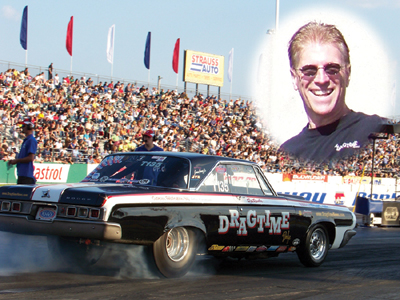| (Find
more More Bracket Racing 101 articles HERE)
 In
"It's All In The Timing, Pt. 1", Al Smyth
from Portatree Systems (www.PortaTree.com)
helped us dissect the beginning portion of the dragstrip,
specifically the timing system at the starting line. Now
that we’ve hit the gas and are off and running, let’s
take a look at the various increments we’ll encounter
along the way. In
"It's All In The Timing, Pt. 1", Al Smyth
from Portatree Systems (www.PortaTree.com)
helped us dissect the beginning portion of the dragstrip,
specifically the timing system at the starting line. Now
that we’ve hit the gas and are off and running, let’s
take a look at the various increments we’ll encounter
along the way.
The
typical 1/4 mile dragstrip is wired with timing sensors
at 60 ft., 330 ft., 660 ft., 1,000 ft., and 1,320 ft. In
addition to these timing sensors, there are speed clocks
at 660 ft. and 1,320 ft. Each of these increments are useful
to us bracket racers when trying to tune a vehicle or figure
out what the vehicle would have actually run if we hadn’t
lifted before the stripe.
I asked
Al to discuss the various increments. “60 foot times
are a great indicator of track conditions and starting line
performance of the race vehicle. Suspension adjustments
as well as clutch refinement are all part of the 60 ft.
number interpretation.” This is the first increment
to look at when you’re doing a mental run-completion
after a pass in which you lifted before the stripe. “330
ft. times are a good reference for acceleration and shift
point adjusting. You can make all sorts of changes to enhance
the 330 ft. time in order to improve the acceleration of
the race vehicle.” I’ve experienced fluctuating
330 ft. times when I had a rear-suspension issue that caused
the Dodge to unload the rear tires after the 60 ft. clocks.
The
first increment that includes both time and speed is the
660 ft. “The 660 ft. time is the first you receive
after you are in your final gear. Some vehicles shift into
a final gear after the 660, but you will find that they
are few and far between. The 660 ft. MPH is important as
well because it can be used as a horsepower indicator.”
I use the 660 ft. number to figure out what kind of pass
the Dodge was on during windy conditions because wind is
less of an issue at mid-track vs. at the finish line.
The
1000 ft. increment is the big one we use to complete a run.
In reality, the 1,000 ft. data is probably more important
than the ET at the stripe. If we’re doing our jobs
correctly, the final ET will be all over the place throughout
the raceday (thanks to lifting, killing, whomping, etc.),
and we’ll be using the 1,000 ft. number to figure
out what to dial. In a future column I’ll be dissecting
a time slip, so this will be discussed in more depth at
that time.
Now
we’re finally at the stripe; I asked Al about the
distance between the MPH clock and the finish line, and
about the finish-line beams: “The MPH trap has been
set to a 66 ft. standard for over 20 years. You are actually
getting an average speed across the 66 ft. distance prior
to completing the race. All non-starting-line sensors are
6 inches off the track surface. The only exception is the
60 ft. clocks which are 10 inches off the surface to capture
most wheelstands. Therefore all race vehicles start with
sensors that are about 2 inches off the ground and tripped
by the front tires and finish the race with sensors that
are 6 inches off the ground and usually tripped by the body.
Keep in mind that most race cars at rest have bodies that
are lower than 6 inches ahead of the front tires. Under
full acceleration the body will be higher than the finish
line beam but any sudden stop in acceleration at the finish
line could cause a premature trip of the finish beam with
the nose of the race car. Example: race car has an 18 inch
overhang. Top speed of the race car is 120 MPH which is
176 feet per second. Converting to inches and thousandths
of a second makes the race car going about 2 inches every
.001 seconds. If the nose trips early, then the 18 inch
overhang will lower the ET by .009 seconds. MPH is affected
as well. The MPH formula is 45 divided by the time the race
vehicle is in the trap. At 120 MPH the race vehicle goes
through the trap in .375 seconds. If we lower the trap time
from .375 to .366 then the MPH will go from 120 MPH to 122.95
MPH!!” So in this example, if you dialed 11.00 and
were on a dead-on pass but hit the brakes at the wrong time,
you could actually break out with a 10.991, and have a higher
MPH to boot!
Thanks
for reading and good luck at the track.
|



